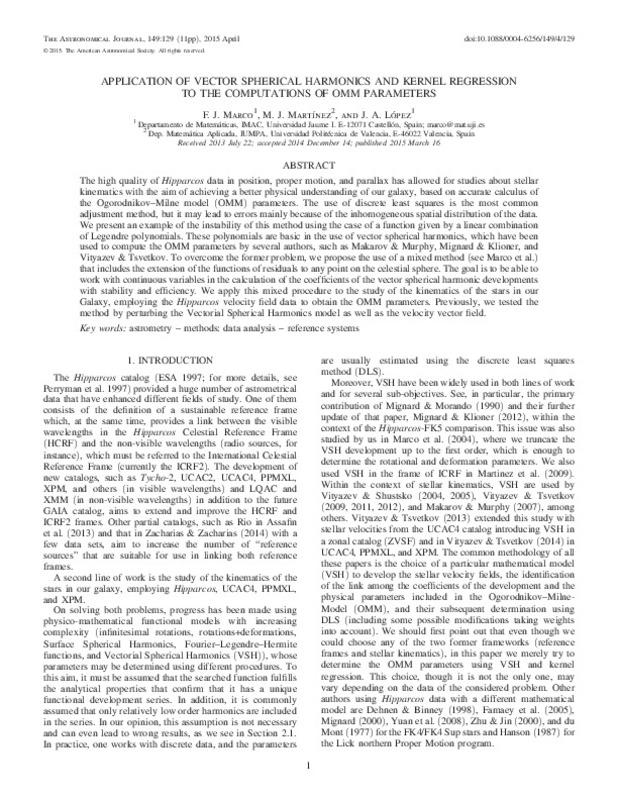JavaScript is disabled for your browser. Some features of this site may not work without it.
Buscar en RiuNet
Listar
Mi cuenta
Estadísticas
Ayuda RiuNet
Admin. UPV
Application of Vector Spherical Harmonics and Kernel Regression to the computations of OMM Parameters
Mostrar el registro sencillo del ítem
Ficheros en el ítem
| dc.contributor.author | Marco Castillo, Francisco Javier
|
es_ES |
| dc.contributor.author | Martínez Uso, María José
|
es_ES |
| dc.contributor.author | Lopez, J.A.
|
es_ES |
| dc.date.accessioned | 2016-06-08T07:45:34Z | |
| dc.date.available | 2016-06-08T07:45:34Z | |
| dc.date.issued | 2015-04 | |
| dc.identifier.issn | 0004-6256 | |
| dc.identifier.uri | http://hdl.handle.net/10251/65495 | |
| dc.description.abstract | The high quality of Hipparcos data in position, proper motion, and parallax has allowed for studies about stellar kinematics with the aim of achieving a better physical understanding of our galaxy, based on accurate calculus of the Ogorodnikov-Milne model (OMM) parameters. The use of discrete least squares is the most common adjustment method, but it may lead to errors mainly because of the inhomogeneous spatial distribution of the data. We present an example of the instability of this method using the case of a function given by a linear combination of Legendre polynomials. These polynomials are basic in the use of vector spherical harmonics, which have been used to compute the OMM parameters by several authors, such as Makarov & Murphy, Mignard & Klioner, and Vityazev & Tsvetkov. To overcome the former problem, we propose the use of a mixed method (see Marco et al.) that includes the extension of the functions of residuals to any point on the celestial sphere. The goal is to be able to work with continuous variables in the calculation of the coefficients of the vector spherical harmonic developments with stability and efficiency. We apply this mixed procedure to the study of the kinematics of the stars in our Galaxy, employing the Hipparcos velocity field data to obtain the OMM parameters. Previously, we tested the method by perturbing the Vectorial Spherical Harmonics model as well as the velocity vector field. | es_ES |
| dc.description.sponsorship | Part of this work was supported by a grant P1-1B2012-47 from UJI. | en_EN |
| dc.language | Inglés | es_ES |
| dc.publisher | American Astronomical Society | es_ES |
| dc.relation.ispartof | Astronomical Journal | es_ES |
| dc.rights | Reserva de todos los derechos | es_ES |
| dc.subject | astrometry | es_ES |
| dc.subject | methods: data analysis | es_ES |
| dc.subject | reference systems | es_ES |
| dc.subject.classification | MATEMATICA APLICADA | es_ES |
| dc.title | Application of Vector Spherical Harmonics and Kernel Regression to the computations of OMM Parameters | es_ES |
| dc.type | Artículo | es_ES |
| dc.identifier.doi | 10.1088/0004-6256/149/4/129 | |
| dc.relation.projectID | info:eu-repo/grantAgreement/UJI//P1·1B2012-47/ | es_ES |
| dc.rights.accessRights | Abierto | es_ES |
| dc.contributor.affiliation | Universitat Politècnica de València. Departamento de Matemática Aplicada - Departament de Matemàtica Aplicada | es_ES |
| dc.description.bibliographicCitation | Marco Castillo, FJ.; Martínez Uso, MJ.; Lopez, J. (2015). Application of Vector Spherical Harmonics and Kernel Regression to the computations of OMM Parameters. Astronomical Journal. 149(4):1-11. https://doi.org/10.1088/0004-6256/149/4/129 | es_ES |
| dc.description.accrualMethod | S | es_ES |
| dc.relation.publisherversion | http://dx.doi.org/10.1088/0004-6256/149/4/129 | es_ES |
| dc.description.upvformatpinicio | 1 | es_ES |
| dc.description.upvformatpfin | 11 | es_ES |
| dc.type.version | info:eu-repo/semantics/publishedVersion | es_ES |
| dc.description.volume | 149 | es_ES |
| dc.description.issue | 4 | es_ES |
| dc.relation.senia | 283355 | es_ES |
| dc.identifier.eissn | 1538-3881 | |
| dc.contributor.funder | Universitat Jaume I | es_ES |








